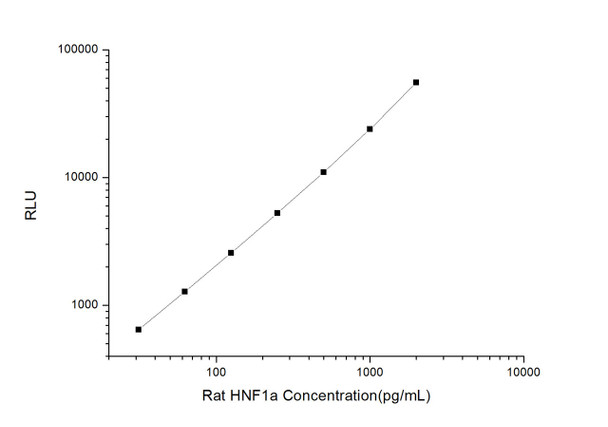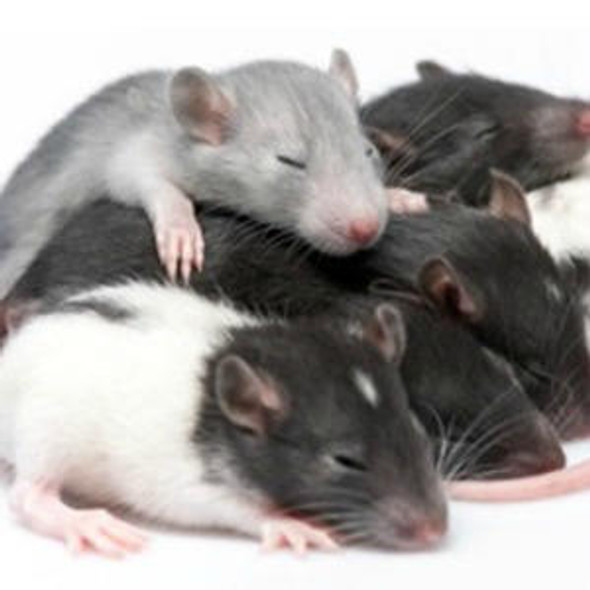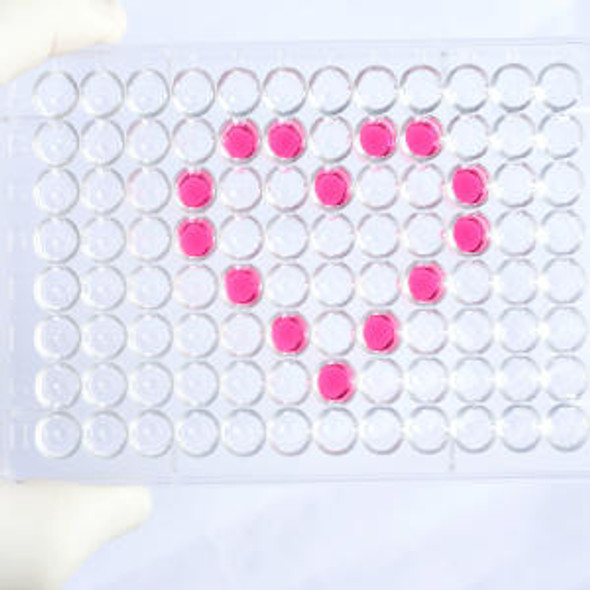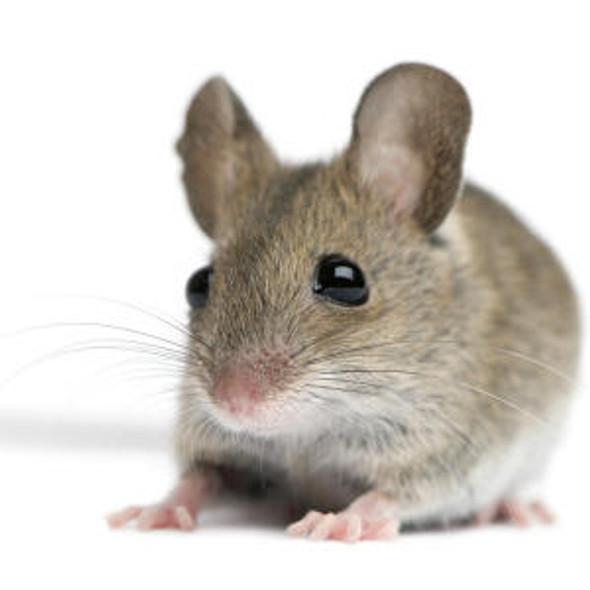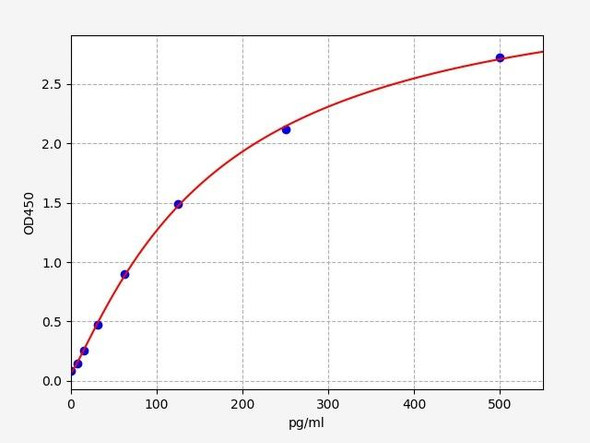Rat Signaling ELISA Kits 3
Rat HNF1a (Hepatocyte Nuclear Factor 1 Alpha) CLIA Kit (RTES00293)
- SKU:
- RTES00293
- Product Type:
- ELISA Kit
- ELISA Type:
- CLIA Kit
- Size:
- 96 Assays
- Sensitivity:
- 18.75pg/mL
- Range:
- 31.25-2000pg/mL
- ELISA Type:
- Sandwich
- Reactivity:
- Rat
- Sample Type:
- Serum, plasma and other biological fluids
- Research Area:
- Epigenetics and Nuclear Signaling
Description
| Assay type: | Sandwich |
| Format: | 96T |
| Assay time: | 4.5h |
| Reactivity: | Rat |
| Detection method: | Chemiluminescence |
| Detection range: | 31.25-2000 pg/mL |
| Sensitivity: | 18.75 pg/mL |
| Sample volume: | 100µL |
| Sample type: | Serum, plasma and other biological fluids |
| Repeatability: | CV < 15% |
| Specificity: | This kit recognizes Rat HNF1a in samples. No significant cross-reactivity or interference between Rat HNF1a and analogues was observed. |
This kit uses Sandwich-CLIA as the method. The micro CLIA plate provided in this kit has been pre-coated with an antibody specific to Rat HNF1a. Standards or samples are added to the appropriate micro CLIA plate wells and combined with the specific antibody. Then a biotinylated detection antibody specific for Rat HNF1a and Avidin-Horseradish Peroxidase (HRP) conjugate are added to each micro plate well successively and incubated. Free components are washed away. The substrate solution is added to each well. Only those wells that contain Rat HNF1a, biotinylated detection antibody and Avidin-HRP conjugate will appear fluorescence. The Relative light unit (RLU) value is measured spectrophotometrically by the Chemiluminescence immunoassay analyzer. The RLU value is positively associated with the concentration of Rat HNF1a. The concentration of Rat HNF1a in the samples can be calculated by comparing the RLU of the samples to the standard curve.
| UniProt Protein Function: | HNF1A: Transcriptional activator that regulates the tissue specific expression of multiple genes, especially in pancreatic islet cells and in liver. Required for the expression of several liver specific genes. Binds to the inverted palindrome 5'- GTTAATNATTAAC-3'. Defects in HNF1A are a cause of hepatic adenomas familial (HEPAF). Hepatic adenomas are rare benign liver tumors of presumable epithelial origin that develop in an otherwise normal liver. Hepatic adenomas may be single or multiple. They consist of sheets of well-differentiated hepatocytes that contain fat and glycogen and can produce bile. Bile ducts or portal areas are absent. Kupffer cells, if present, are reduced in number and are non-functional. Conditions associated with adenomas are insulin-dependent diabetes mellitus and glycogen storage diseases (types 1 and 3). Bi-allelic inactivation of HNF1A, whether sporadic or associated with MODY3, may be an early step in the developmant of some hepatocellular carcinomas. Defects in HNF1A are the cause of maturity-onset diabetes of the young type 3 (MODY3); also symbolized MODY-3. MODY is a form of diabetes that is characterized by an autosomal dominant mode of inheritance, onset in childhood or early adulthood (usually before 25 years of age), a primary defect in insulin secretion and frequent insulin-independence at the beginning of the disease. Defects in HNF1A are the cause of susceptibility to diabetes mellitus insulin-dependent type 20 (IDDM20). IDDM20 is a multifactorial disorder of glucose homeostasis that is characterized by susceptibility to ketoacidosis in the absence of insulin therapy. Clinical fetaures are polydipsia, polyphagia and polyuria which result from hyperglycemia-induced osmotic diuresis and secondary thirst. These features can result in long-term complications that affect the eyes, kidneys, nerves, and blood vessels. Belongs to the HNF1 homeobox family. 3 isoforms of the human protein are produced by alternative splicing. |
| UniProt Protein Details: | Protein type:Transcription factor; DNA-binding Cellular Component: nucleoplasm; transcription factor complex; protein complex; photoreceptor outer segment; cell; pronucleus; cytoplasm; nucleus Molecular Function:protein dimerization activity; protein binding; protein homodimerization activity; DNA binding; sequence-specific DNA binding; protein heterodimerization activity; double-stranded DNA binding; transcription factor activity; transcription factor binding Biological Process: transcription from RNA polymerase II promoter; blastocyst development; paraxial mesoderm formation; positive regulation of transcription, DNA-dependent; negative regulation of transcription from RNA polymerase II promoter; glucose homeostasis; bile acid and bile salt transport; protein localization; regulation of transcription, DNA-dependent; response to glucose stimulus; fatty acid biosynthetic process; placenta development; bone resorption; embryonic limb morphogenesis; cholesterol metabolic process; bile acid biosynthetic process; regulation of hormone secretion; regulation of Wnt receptor signaling pathway; liver development; endocrine pancreas development; regulation of transcription from RNA polymerase II promoter; chromatin remodeling; reverse cholesterol transport; insulin secretion; glucose import; positive regulation of transcription from RNA polymerase II promoter; response to oxidative stress; reproductive structure development; regulation of insulin secretion; fatty acid transport; heme biosynthetic process |
| NCBI Summary: | acts as a transcriptional activator; plays a role in the regulation of liver-specific genes [RGD, Feb 2006] |
| UniProt Code: | P15257 |
| NCBI GenInfo Identifier: | 6981638 |
| NCBI Gene ID: | 24817 |
| NCBI Accession: | NP_036801. 1 |
| UniProt Related Accession: | P15257 |
| Molecular Weight: | 67,213 Da |
| NCBI Full Name: | hepatocyte nuclear factor 1-alpha |
| NCBI Synonym Full Names: | HNF1 homeobox A |
| NCBI Official Symbol: | Hnf1a |
| NCBI Official Synonym Symbols: | HNF1; Lfb1; Tcf1; LF-B1 |
| NCBI Protein Information: | hepatocyte nuclear factor 1-alpha |
| UniProt Protein Name: | Hepatocyte nuclear factor 1-alpha |
| UniProt Synonym Protein Names: | Liver-specific transcription factor LF-B1; LFB1; Transcription factor 1; TCF-1 |
| Protein Family: | Hepatocyte nuclear factor |
| UniProt Gene Name: | Hnf1a |
| UniProt Entry Name: | HNF1A_RAT |
As the RLU values of the standard curve may vary according to the conditions of the actual assay performance (e. g. operator, pipetting technique, washing technique or temperature effects), the operator should establish a standard curve for each test. Typical standard curve and data is provided below for reference only.
| Concentration (pg/mL) | RLU | Average | Corrected |
| 2000 | 54035 57407 | 55721 | 55693 |
| 1000 | 23910 24038 | 23974 | 23946 |
| 500 | 11190 10874 | 11032 | 11004 |
| 250 | 4868 5720 | 5294 | 5266 |
| 125 | 2729 2487 | 2608 | 2580 |
| 62.5 | 1396 1226 | 1311 | 1283 |
| 31.25 | 658 690 | 674 | 646 |
| 0 | 27 29 | 28 | -- |
Precision
Intra-assay Precision (Precision within an assay): 3 samples with low, mid range and high level Rat HNF1a were tested 20 times on one plate, respectively.
Inter-assay Precision (Precision between assays): 3 samples with low, mid range and high level Rat HNF1a were tested on 3 different plates, 20 replicates in each plate.
| Intra-assay Precision | Inter-assay Precision | |||||
| Sample | 1 | 2 | 3 | 1 | 2 | 3 |
| n | 20 | 20 | 20 | 20 | 20 | 20 |
| Mean (pg/mL) | 92.65 | 192.22 | 797.09 | 86.02 | 177.86 | 741.49 |
| Standard deviation | 10.01 | 19.95 | 64.09 | 8.65 | 18.76 | 49.16 |
| C V (%) | 10.80 | 10.38 | 8.04 | 10.06 | 10.55 | 6.63 |
Recovery
The recovery of Rat HNF1a spiked at three different levels in samples throughout the range of the assay was evaluated in various matrices.
| Sample Type | Range (%) | Average Recovery (%) |
| Serum (n=5) | 87-97 | 92 |
| EDTA plasma (n=5) | 86-100 | 93 |
| Cell culture media (n=5) | 101-116 | 108 |
Linearity
Samples were spiked with high concentrations of Rat HNF1a and diluted with Reference Standard & Sample Diluent to produce samples with values within the range of the assay.
| Serum (n=5) | EDTA plasma (n=5) | Cell culture media (n=5) | ||
| 1:2 | Range (%) | 97-108 | 100-118 | 92-105 |
| Average (%) | 102 | 108 | 99 | |
| 1:4 | Range (%) | 87-103 | 95-108 | 88-104 |
| Average (%) | 94 | 100 | 95 | |
| 1:8 | Range (%) | 95-105 | 97-114 | 93-109 |
| Average (%) | 100 | 105 | 100 | |
| 1:16 | Range (%) | 93-107 | 95-110 | 89-104 |
| Average (%) | 99 | 102 | 95 |
An unopened kit can be stored at 4°C for 1 month. If the kit is not used within 1 month, store the items separately according to the following conditions once the kit is received.
| Item | Specifications | Storage |
| Micro CLIA Plate(Dismountable) | 8 wells ×12 strips | -20°C, 6 months |
| Reference Standard | 2 vials | |
| Concentrated Biotinylated Detection Ab (100×) | 1 vial, 120 µL | |
| Concentrated HRP Conjugate (100×) | 1 vial, 120 µL | -20°C(shading light), 6 months |
| Reference Standard & Sample Diluent | 1 vial, 20 mL | 4°C, 6 months |
| Biotinylated Detection Ab Diluent | 1 vial, 14 mL | |
| HRP Conjugate Diluent | 1 vial, 14 mL | |
| Concentrated Wash Buffer (25×) | 1 vial, 30 mL | |
| Substrate Reagent A | 1 vial, 5 mL | 4°C (shading light) |
| Substrate Reagent B | 1 vial, 5 mL | 4°C (shading light) |
| Plate Sealer | 5 pieces | |
| Product Description | 1 copy | |
| Certificate of Analysis | 1 copy |
- Set standard, test sample and control (zero) wells on the pre-coated plate and record theirpositions. It is recommended to measure each standard and sample in duplicate. Note: addall solutions to the bottom of the plate wells while avoiding contact with the well walls. Ensuresolutions do not foam when adding to the wells.
- Aliquot 100µl of standard solutions into the standard wells.
- Add 100µl of Sample / Standard dilution buffer into the control (zero) well.
- Add 100µl of properly diluted sample (serum, plasma, tissue homogenates and otherbiological fluids. ) into test sample wells.
- Cover the plate with the sealer provided in the kit and incubate for 90 min at 37°C.
- Aspirate the liquid from each well, do not wash. Immediately add 100µL of BiotinylatedDetection Ab working solution to each well. Cover the plate with a plate seal and gently mix. Incubate for 1 hour at 37°C.
- Aspirate or decant the solution from the plate and add 350µL of wash buffer to each welland incubate for 1-2 minutes at room temperature. Aspirate the solution from each well andclap the plate on absorbent filter paper to dry. Repeat this process 3 times. Note: a microplatewasher can be used in this step and other wash steps.
- Add 100µL of HRP Conjugate working solution to each well. Cover with a plate seal andincubate for 30 min at 37°C.
- Aspirate or decant the solution from each well. Repeat the wash process for five times asconducted in step 7.
- Add 100µL of Substrate mixture solution to each well. Cover with a new plate seal andincubate for no more than 5 min at 37°C. Protect the plate from light.
- Determine the RLU value of each well immediately.

